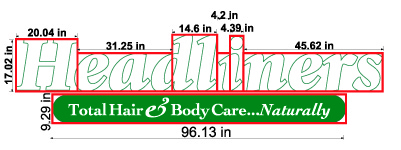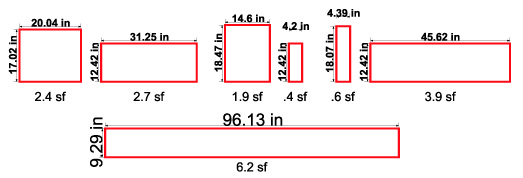August 29, 2011
The Fast Way to a Sign Permit

Your client is ready to pull the trigger on your proposed sign. It is all good except…you need to check with the city regarding sign code requirements in your client’s area. What is the best way to get a sign permit quickly? The answer is to cover your bases in advance.
This post outlines some smart steps to help speed your permit application approval.
FULL DISCLOSURE: This post does not necessarily cover all of the items needed to obtain a sign permit in your operating area. Different areas have different requirements, and either more or less information may be needed. Also, this post uses a wall mounted channel letter sign as an example – other sign types may have more or fewer permit requirements.
CHECK THE PROPERTY OWNER’S REQUIREMENTS So, the city says your channel letter sign is fine as it is? Terrific. But what about the property owner? They may have a differing requirement. It is imperative to get any and all property owner sign requirements prior to approaching the city for a permit. The smart strategy is to take your detailed diagram of what you have in mind and show it to the owner. Show them your details, colors, specifications, everything. If they approve of what you have in mind, then get a signed letter stating that they have reviewed your sign’s design and are OK with it. Some cities are now requiring a copy of this letter prior to reviewing a sign permit application. Another item to find out from the property owner is how much space was originally allocated to your client’s sign. The final development plans will often have this information. Check that your initial design footprint does not exceed the space allocated to your client’s storefront.
GET A USE PERMIT What else should you have in your bag of permit tricks? A use permit (also known as a “for use permit”.) This document states the city is aware of the business activity that will take place at your client’s location within that city zoning area, and is OK with it. This document is sometimes required to process a sign permit.
SETBACK Another item you may need is the setback of your proposed sign site. A setback is the distance from the property line to the front of the building. This information can usually be supplied by the building owner or their authorized representative. The city may also have this information. The final development plan (or the FDP) is a public record document that will have this information.
LINEAR FRONTAGE This is the straight horizontal width of the storefront. If your client intends to occupy more than one storefront (adjacent spaces), then you need to measure the distance of all the spaces your client will occupy.
SIGN ARTWORK AND DIAGRAMS Take a copy of your detailed sign artwork, including all colors and dimensions. It may also be helpful to take a photo simulation of your proposed sign (If you have a JPEG image of the building, you can use our channel letter Sign Builder to produce a photo.) Another helpful information item is an exploded sign diagram. Our channel letter cut sheet diagrams may be helpful.
SQUARE FOOTAGE CALCULATION The next item you will need to calculate is the wall footprint of your channel letter sign. By a “wall footprint”, I mean the sign’s square footage on the wall. And here is the kicker – you must check with the city on how they measure sign square footage. Some cities will measure sign square footage like this – a simple rectangle is outlined around the channel letter sign:
Channel Letter Square Footage Calculation
Total square footage = 120.02/12 (10ft.) * 28.75/12 (2.4 ft.) = 24 square feet
Other cities measure it like this, eliminating the “white space”:
Alternate Channel Letter Sign Square Footage Calculation
When that is the city’s method, separate the individual areas of the sign into boxes as the above example shows. That gives you this:
Final Channel Letter Square Foot Calculation
Then your square foot calculation is simple. It comes to: 2.4 + 2.7 + 1.9 + .4 + .6 + 3.9 + 6.2 = 18.1 square feet. Other cities may have different methods of square foot measurement – these are just 2 examples. Always check on how your city calculates this number. You may also want to use an outside sign permitting company. If you don’t have time to find out the details of how a given city does their permitting, these companies will assemble all of the details necessary for you to obtain a sign permit.
Here is one vendor: http://www.signcodeinc.com
APPROVAL FROM ADDITIONAL AUTHORITIES Here is another item to check on. Does a sign permit at this location require approval from more than one entity? There are locations that require approval from more than just the city. For example, in some cities you must have approval from both the local “Architectural Planning Committee” and the city itself to receive a sign permit. And you must get the Architectural Planning Committee’s approval first – only after you have that approval in hand can you approach the city.
NIT CALCULATION Last, find out if your city requires a NIT calculation (NIT is a measurement of the sign’s illuminance level, or light intensity.) Once again, your area may or may not require that – check to be sure. If needed, the NIT figure may be supplied by the sign’s manufacturer. If you made the sign yourself, check with the illumination manufacturer.
So your punch list of critical sign permit approval items is:
* Property owner sign requirements and original sign space allocation
* Signed letter of approval from property owner
* Use (or for use) permit (if necessary)
* Building setback
* Linear foot measurement of storefront
* Sign artwork and diagrams
* Sign square footage measurement (using calculation procedure supplied by city)
* Approval from other city/county entities (if necessary)
* NIT calculation (If necessary)
Completing this list gives you a good chance of fast permit approval. Half the battle is checking on which items are needed by the owner and city, and gathering those items as far in advance as possible.


